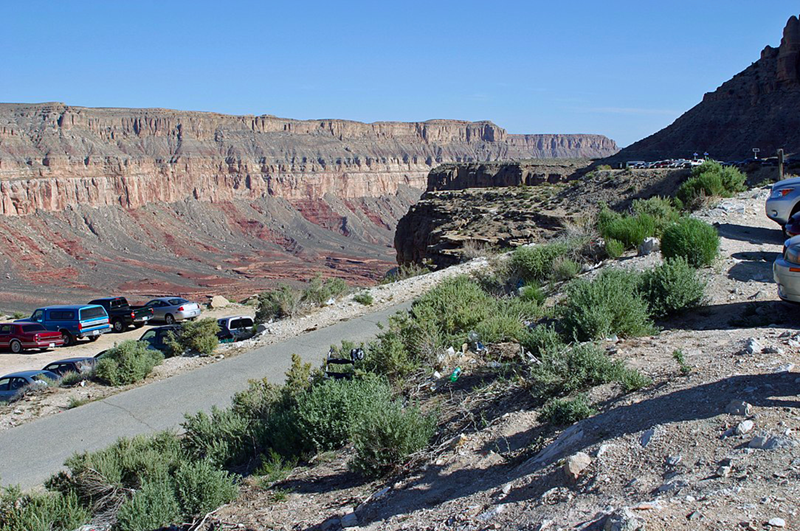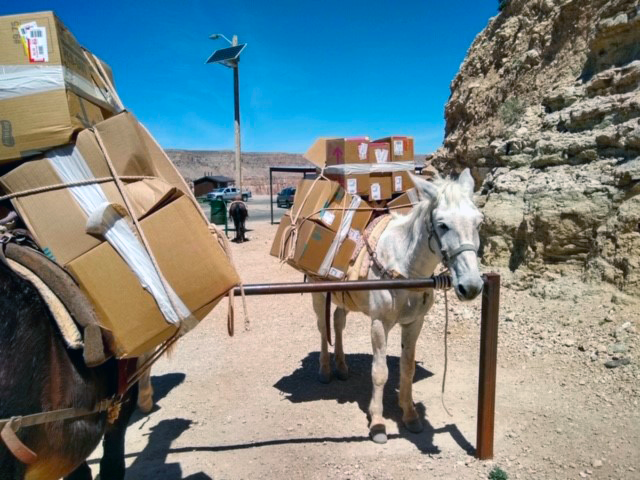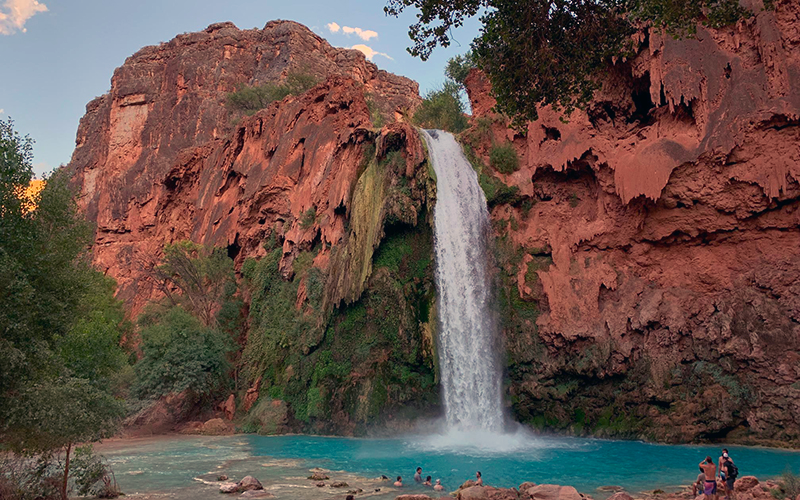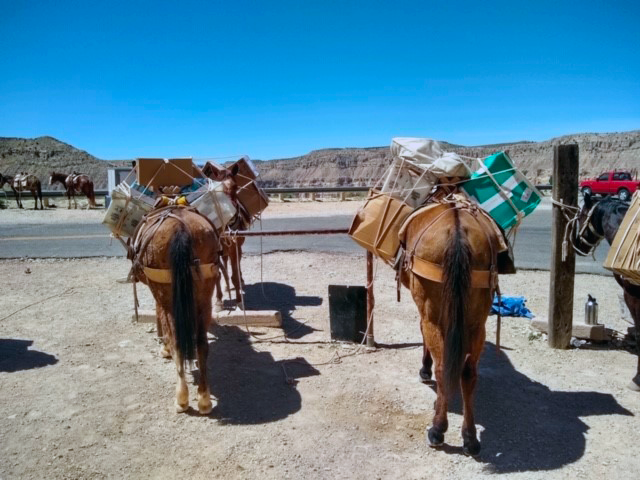Few adventures leave an imprint of fantastic, self-enclosed worlds as intense as the ones displaying discoveries of forsaken paradises on Earth. Jules Verne’s Journey to the Center of the Earth is one of them. Verne imagined a subterranean world with ancient flora and fauna accessed by volcanic tubes, though the book manages to leave to the imagination what the film adaptations never achieved.
Steven Spielberg’s Close Encounters of the Third Kind also plays with ancient symbols of lost worlds when the story sets an incredible encounter between Roy Neary, an Indiana blue-collar worker, and a UFO landed on a cylindric butte in a remote area of the American West. The place chosen by Spielberg is Bear Lodge Butte in Wyoming (also Devils Tower), vertically rising its shape of igneous rock 1,267 feet (386 meters) above its surroundings.

Bear Lodge isn’t the only butte used by science fiction to depict the remains of an ancient world. Arthur Conan Doyle’s novel The Lost World imagines an expedition to a plateau in the Amazon basin where prehistoric animals have been able to survive.
The place that inspired Conan Doyle’s novel is Mount Roraima, a giant tepui (or mesa from the highlands) in the junction of Venezuela, Brazil, and Guyana, reaching 8,000 feet like a remote island in the sky with its own microclimate, flora, and fauna. No sign of Conan Doyle’s Jurassic speculations, however, though the sandstone formation itself is a remnant of the Gondwana’s supercontinent.
Grand Canyon “time” and contemporary attention span
Ancient, eroded rock formations remind us of a geologic time, thus helping us contrast our world of presentism with the slow path of geochronology. At the Grand Canyon National Park, in Arizona, the contrast between the landscape’s time and our pressing attitude towards every activity can help us reflect on our attention span or the relative importance of all the pressing things that undermine our ability to focus, regain our attention span, or read slowly instead of churning things as soon as possible.

Perhaps, contemporary culture reacts in awe to self-enclosed worlds rooted in nature due to our inability to relate to our surroundings in a meaningful way. We struggle to name natural things around us, and most of us lack the patience to observe plants, watch animals, or observe the day going, let alone the seasons.
From today’s pop culture perspective of brand-sponsored influencers, however, we approach these worlds with the attitude of backpackers ready to unsheathe the smartphone and selfie and livestream the heck out of it, an urge already present in the background of Alex Garland’s 1996 novel The Beach, adapted to cinema in 2000 by Danny Boyle. The protagonist, tired of tourism, sets for an idyllic, pristine beach unscathed by massification, yet his “intentional community of backpackers” is a mere outpost of what was about to come. Michel Houellebecq will explore the topic in his 2001 novel Plateforme (Platform).
The name of the things around you
Ever since figures in the Enlightenment such as Jean-Jacques Rousseau idealized native peoples as bearers of the well-natured innocence that preceded, according to them, any of the scars left by the dysfunctions of socialization, films of distant, lost worlds like those mentioned echoes our fascination for the last uncontacted tribes from the Amazon basin, the Andaman islands, and New Guinea. While calling our civilization rational and scientific, we keep craving myths like the paradise on Earth.
The contact of Europeans and other colonizing civilizations with natives unleashed a world (of trauma, decimation, and exploitation, according to evidence; of “exchange,” according to the traditional perception of the Columbian encounter). In North America, Native Americans are still looking their way and attempting to thrive in a vernacular (in culture, in self-pride, in architecture) decided by them instead of being imposed by outsiders.
The National Park Service recently renamed a Grand Canyon trail to honor the tribe that claimed the site as their home before they were forcibly removed from the area once it was granted protection in 1928. Congress created the Grand Canyon National Park in 1919, stating:
“That nothing herein contained shall affect the rights of the Havasupai Tribe of Indians to the use and occupancy of the bottom lands of the Canyon of Cataract Creek.”
The Bright Angel Trail, originally called Ha’a Gyoh, becomes the Havasupai Gardens.
The traditional territory of the Havasupai comprised a bigger area of the canyons and plateaus that still concentrates its descendants, farming inside the canyons in spring and summer and living up in the plateau during the cold months.
Lee Marshall and the Havasu land
The Havasupai tribe (“people of the blue-green waters”) still inhabits the Havasu Canyon, a place with otherworldly waterfalls, a nearby reservation within the inner rim of the Grand Canyon; visitors (and the US Postal Service “mule train delivery“) have to access either by foot or on mule or horse. Now closed to tourism until the 2023 season after a decision by their seven-member council, the capital of the reservation, Supai, is at the bottom of Havasu “Cataract” Canyon, one of the most spectacular tributary canyons.

In his essay about the Havasupai people, Stephen Hirst mentions one tense encounter between the park’s service and the tribe’s council that synthesizes the struggle to be recognized in their own land most Native American tribes have experienced: in 1971, the federal government proposed adding more Havasupai land into the Grand Canyon National Park, after consultation with environmental experts from the Sierra Club and other organizations. At a hearing, Tribal Chairman Lee Marshall declared:
“I heard all you people talking about the Grand Canyon,” he said. “Well, you’re looking at it. I am the Grand Canyon!”
In an appeal to the Secretary of the Interior —head of national parks legislation— and the Secretary of Agriculture —in charge of national forests— in 1972, the Havasupai vindicated their rights concerning traditional use areas, stating:
“We care more deeply for the beauty of our land than Sunday hikers or professional environmentalists because this land is part of us, and we live on it… We are human beings with the right to survive, not rocks or dust. This is not a zoo.”
A mere three years later, the Havasupai celebrated the return of 95,000 acres thanks to new legislation signed by Gerald Ford.
An unexpectedly consequent hike to the bottom of the Grand Canyon
Down in the Havasu canyon, things bear a different rhythm than the one the visitor is obliged to leave at the parking lot up in the plateau: that of the Havasu creek and the Colorado river water eroding the canyon since time immemorial, a pace known and revered by those inhabitants of the reservation who decided to stay in Supai instead of settling in the more convenient surrounding plateaus, or anywhere else outside their ancestral land. The same area, constrained by the river and the sandstone and mudstone walls that grant the place’s isolation, that Lee Marshall had declared essential for the survival of a people and their culture.

Going down the 8-mile trail at the bottom of the canyon requires reclaiming one’s time and patience, and it feels refreshing. Kirsten and I walked down that trail eighteen years ago, one year after meeting in Barcelona for the first time, and one trip across the US Southwest brought us to a one-of-a-kind opportunity in a world that was becoming more connected, narrowing our attention span and promoting an intense, automated micromanaging of our time and experiences.
Enclosed inside the Canyon 2,000 feet below its rim, the town of Supai (450 inhabitants) isn’t accessible by road and is vulnerable to flash floods like the ones in 2018 and 2019, which caused damage and made a part of the valley unstable: a lack of easy access has represented a challenge to restore the most damaged areas.
During our visit in pre-social media times, Stephen Hirst hadn’t published I Am the Grand Canyon yet, and upon arrival to town, we had to confront an old, unresolved struggle of charged perceptions among local people and those arriving from the trail. Unlike other reservations open to ambitious transformation projects that cause tensions between ancestral ties, and fast modernization, the Havasupai Reservation depends on tourism and subsidies to keep its contact with the world outside the canyon, and the pandemic represented a new big threat to the fragile equilibrium of such a small world.
Supai, pop. 208
On our visit during the summer of 2004 (it could have been 2005, no pictures survive from our trip: ah, early digital media!), there were a few humble public buildings that needed serious repair, as most houses did. A few local youngsters hanging by a bench seemed to want to play a damaging stereotype of intoxication and self-destruction despite a warm early afternoon. They had sodas; they were smoking, laughing, making fun of each other, or perhaps making fun of us. Further on the same path, we saw a couple of horses roaming around with a similar self-awareness to that shown by dogs lying in different areas as if they were in charge of counting the daily quota of tourists allowed to go down the trail.
We forgot the name of the Havasupai young man that approached us genuinely interested: where were we from? Our lack of explorer-type, technically outdoorsy clothes set us more apart than a pack of Amish visitors (not infrequent, as we soon attested). He commented on our looks and dismissed his looks as if concerned by his weight. I wondered whether he was well-received among the youngsters we just had passed by. The place was small, he said, small enough to get in trouble.

He had visited some big towns in Arizona, never too far outside the reservation, but his curiosity seemed too big for such secluded surroundings: the bottom of the canyon was isolated enough to have its own dialect, the Havasupai, less spoken than the Hualapai from the southern rim, both belonging to the bigger Yuman-Cochimí family. He placed California, Kirsten’s birthplace, somewhere in the realm of proximity and normalcy, but Spain seemed more exotic, though historically charged among the Natives of the US Southwest, I would learn in our conversation. We remember it vaguely, but there’s no transcription, no notes we can recall other than an email address and a name written on a paper lost in time.
Struggling in paradise
Our new acquaintance didn’t have much to do for the day. He wasn’t older than us, perhaps in his mid-twenties, but he didn’t study nor had to take care of anything. It was a small place, he explained. Did he have relatives? Of course, everybody did down in Supai, but his parents weren’t around. He didn’t elaborate much about the matter, but his insistence on his grandmother’s kindness to him and his siblings sufficed us to understand through omission.
Our cicerone volunteered to show us around and show us the nearest cataract and natural pool in the creek, but before he needed to say a word at home, could we go with him? He lived in a house that was a wooden prefabricated tract home chipped by the elements. Outside, a gigantic satellite dish sat among overgrown weeds: his father had installed it back in the eighties, but he couldn’t recall it working. Inside, nobody was home. He grabbed something from the fridge and some money, and I wondered what he was expecting to do with it, it seemed as symbolic an act as having to keep a satellite dish that doesn’t receive or send signals beyond the canyon walls. He knew the convenience store too well.
We hit the water a little later and blended with some other visitors. A couple of young students from Utah explained to us their missionary endeavors somewhere in South America. Their perception of the world soon seemed as detached from my experience as that of our Havasupai friend, who had shown more interest in what we had to say than in listening to himself talking to strangers. Down in the world, we all were, however, we all seemed to acknowledge that time had slowed down.

A family dressed in traditional, overly warm attires I had seen in documentaries associated with the Amish, long red bear for the father and bonnet for the mother included, came by and cheered us as if they had naturally comprehended that we inhabitants of the world of fast and short attention spans had momentarily come to terms with existence and decided to pause the rat race, if only for a short visit into a world that our Havasupai friend and the Amish family may have perceived as strongholds of a more intentional, slowed down perception things we take for granted or elude with convenience, such as the bliss of a conversation devoid of immediate utility, or the celebration of experienced nature (this visit was years before the race for the perfect social media picture or video).
Land of blue-green water
We may have asked where they were from, as I can recall them saying they were from Wisconsin, a long way from Supai, yet not totally unknown to our local acquaintance —and certainly less exotic than a Spaniard. The family encouraged us to go on and check the creek’s pools and cascades. The red rock canyon narrowed and, amid a riparian habitat of bushes, cottonwood trees, and red flowers I wasn’t familiar with (and the name of “scarlet monkeyflower”), hosted a water flow that echoed and refreshed us as we got closer.
Nobody commented on the water’s color, but its blue was so electrically intense that one could be easily transported to pictures published by Smithsonian or National Geographic; it made sense that the people inhabiting the area had named themselves after it: “blue-green water” (literally, “Havasu”) was about right. Later on, we read that dissolved minerals created such an intense watercolor. I was glad to confirm that our perception had a mundane, geological cause and had not only been caused by the few hours we stayed down in Havasu canyon.
Heading back before night, we saw some California condors playing with wind currents. Near the trail, we could hear some birds accompanying the conversation. It was time to think about the pressing things outside that protected world, beginning with a place to buy some groceries (and enrich our road-trip diet if possible), get gas, and get some sleep. We were driving an old Toyota Camry on cruise control, and had little to say at that moment. It was getting dark when we reached the parking at Haulapai Hilltop.
In need of Huxley’s “soma”
In front of us, a straight, narrow road getting blurry in the sunset. We were heading west. We did not feel pressed anymore like in previous days. Time had melted like a Dalí clock inside the canyon, and we were perhaps envisioning the possibility of a new way of travel. Kirsten was working as a TV freelancer in New York back then, and I worked in Barcelona, but the idea of *faircompanies may have started on that trip back.

The soundtrack could well have been The Band, or perhaps Statesboro Blues by Taj Mahal. On it is a solo guitar played by Jesse Ed Davis on a loop.
Things wouldn’t get slower outside, on the contrary. The battle of media choice against our attention span had just entered a new era, and a mere two years later, big social media, including YouTube, would come into the mix and allow anybody to start their own broadcast with very positive things and also a toll for epistemology, fragmentation, and general attention span.
We may well push back against the worst excesses of an always-on media world and reclaim, like the Havasupai with their ancestral land, the right over our minds. Some saw it coming, with Aldous Huxley, an enamored of the American West, among them.